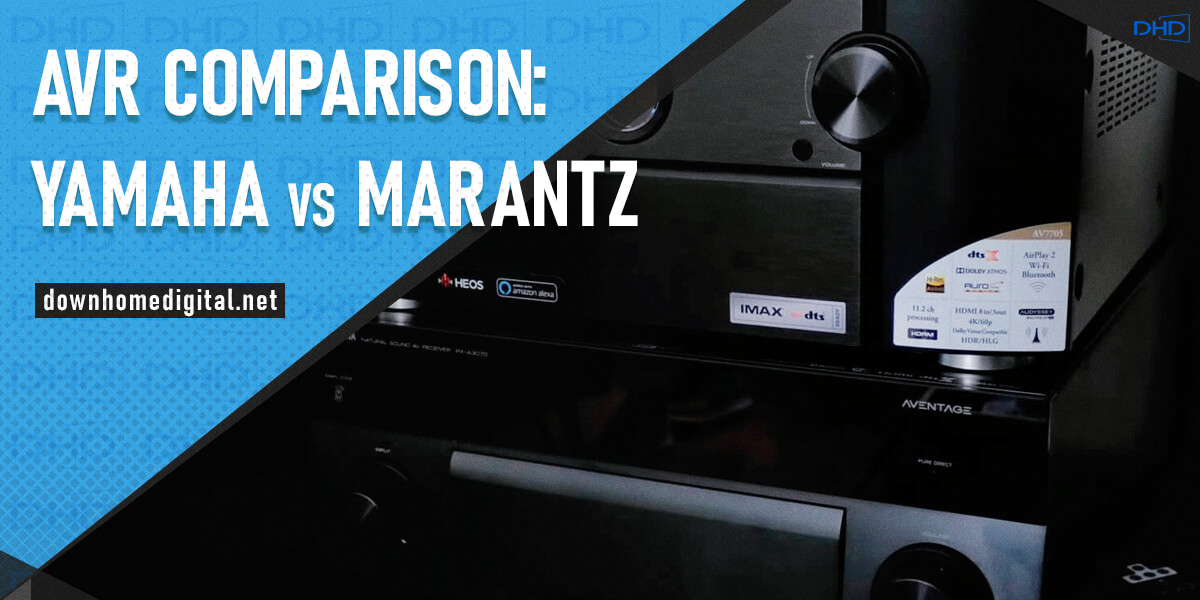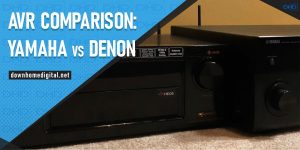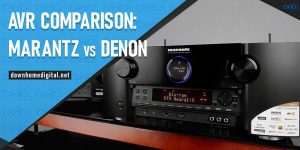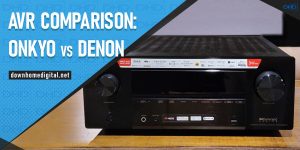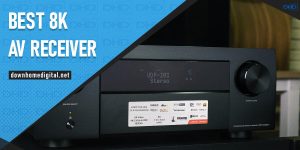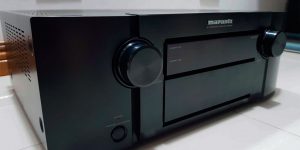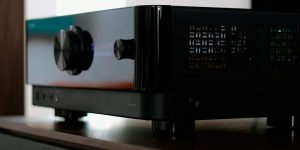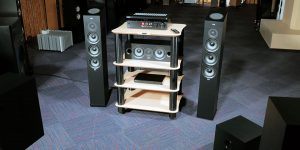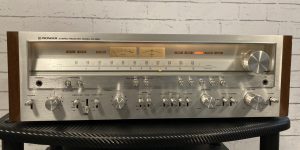Today’s audio world is a symbiosis of different models, technologies, innovations, and of course, competition. Naturally, brands are trying to win as many fans as possible. Such a picture can also be observed in the AV receivers’ niche. And today, I suggest you consider comparing two rather popular brands – Marantz vs. Yamaha.
I compare receivers of these brands because they are very popular, compete in several price segments at once, and their models are close in characteristics. And the main purpose of my tests was to determine which model is the finest in its category, and you could choose the optimal option.
Marantz company history and overview
Today, Marantz is considered one of the most reputable video and audio equipment companies. The American Saul Marantz founded the company in 1953. He was a musician, and he thought about creating high-quality sound-reproducing equipment because none of the devices existing at that time satisfied him.
And from such aspirations, audio equipment appeared, distinguished by high sound quality, flexible change of all necessary sound parameters, reliability, and debugging throughout the entire service life.
Today the name of the company itself – Marantz – has become a mark of quality: a CD player, AV receiver, sound amplifier, and any other device with such a label inspires confidence in the consumer audience. And, it is not surprising that many people want to buy a device exactly from Marantz.
Yamaha company history and overview
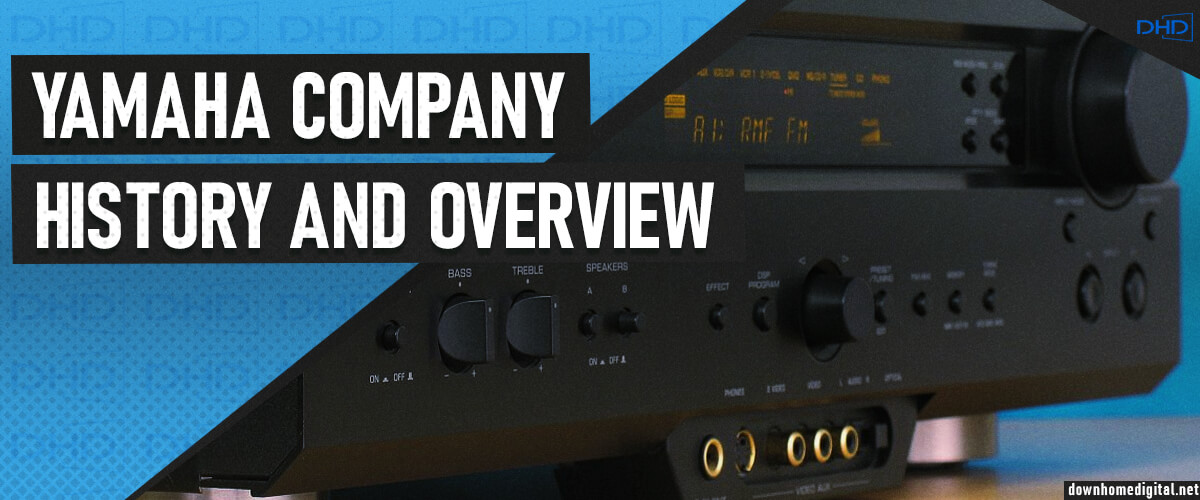
Almost everyone has heard the name “Yamaha” at least once. And this is not surprising. Throughout its long history, the company has won the hearts and minds of fans with its unprecedented quality.
It all started the day when a young entrepreneur Thorakusu Yamaha, a master of the manufacture of reed organs, made a high-quality reed organ for the first time. Shortly after that, a company was founded in 1887 that specialized in producing pianos. And in the same year, it received a large commission from Southeast Asia to assemble 80 organs. Thus, in the first half of the 20th century, the company successfully mastered the technique of producing various musical instruments.
And already, by our time, the company has rightfully become one of the world’s most famous manufacturers of video and audio products. Moreover, Yamaha has received the recognition and respect of the musicians and audiophiles of the planet for the highest sound quality.
How I tested receivers by Marantz and Yamaha
Comprehensive AV receiver comparisons are essential for understanding the strengths and weaknesses of each model in comparison. And that is why I pay attention to both the musical side and the surround sound as part of my testing. I chose The Dark Knight movie, a classic with great dialogue and vivid special effects for my surround sound experience.
And for the music test, I picked up a playlist from my library:
- Bob Marley & The Wailers – Turn Your Lights Down Low – (CD player)
- Mahler – Symphony No.2 (CD player)
- Arctic Monkeys – Do I Wanna Know – (CD player)
- Mark Nauseef – With Space in Mind (CD player)
- The Weeknd – The Hills – (CD player)
I carried each test out on the following equipment:
- CD player SACD 30n
- Blu-ray player Sony UBP-X700
- Speaker wire – AudioQuest Type-9
- Speakers for movie – Klipsch RP-8060FA
- Stereo speakers:
- Klipsch RP-8060FA
- KEF Q350
- DALI OBERON 5
Mid-price Marantz and Yamaha receivers comparison
Marantz SR6015 vs Yamaha RX-A6A
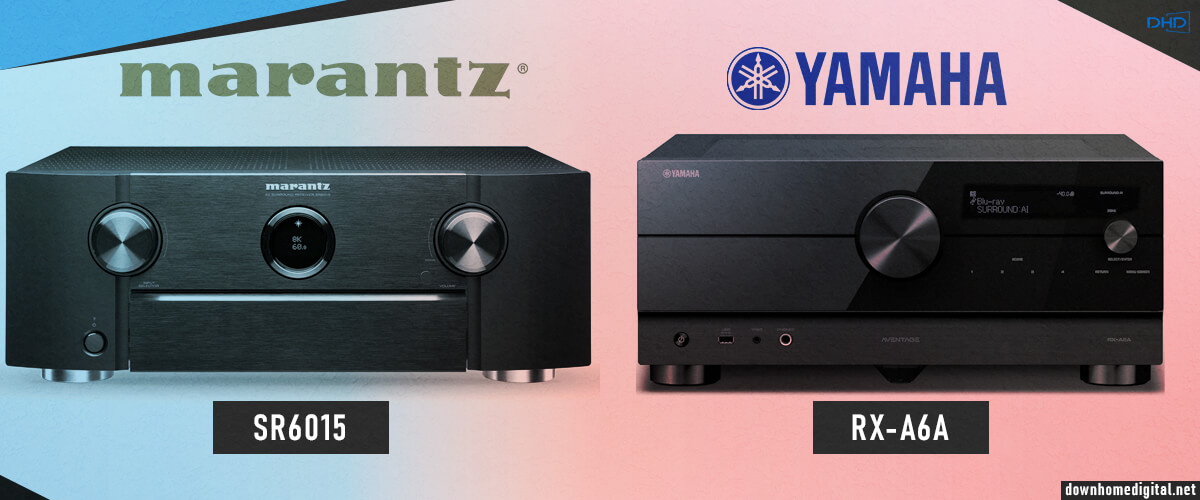
We can start comparing Yamaha vs Marantz models with mid-budget receivers SR6015 and RX-A6A. They are similar in many ways, representing full-fledged 9.2-channel devices with processing of 11 channels with an additional amplifier, support for 8K, compatibility with a huge number of streaming services, and decoding a wide range of surround sound formats. However, some significant differences may affect your choice.
Starting with the design, the receivers have many differences. The SR6015 is smaller and weighs 26.45 pounds. That’s not insignificant for a good AVR, but compared to the 41.2 pounds of the RX-A6A, it’s just small. This fact affects ventilation, and the Marantz SR6015 overheats when operated for long periods, unlike the Yamaha RX-A6A. Both disappointed me with their unassuming LCDs that don’t show anything. But I’m old-school, and I like Marantz’s controls hidden under a protective cover much better than Yamaha’s touchscreen controls. Especially since the Aventage line comes in a glossy case, which leaves dust and fingerprints on it even before you’ve touched the surface, in terms of build quality – both receivers are great. Their components and parts are unquestionable and will last a long time.
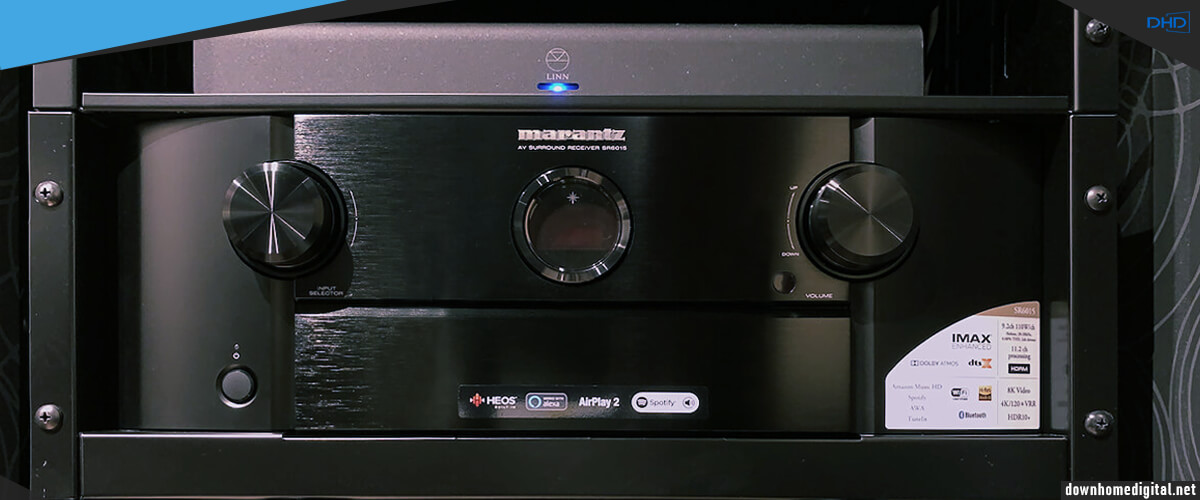
The Marantz SR6015 has nine power amplifiers with an output power of 110 W/8 Ohm . Besides this, the SR6015 is equipped with Dolby Atmos, Dolby Atmos Height Virtualization, DTS:X, DTS Virtual:X, Auro 3D and IMAX Enhanced. RX-A6A rated power (20 Hz – 20 kHz, 2 channels) -150 W (8 ohms, 0.06% MTF), which is important because both models handle 11 channels with the addition of an amplifier, and this power is more suitable for the system. This is important because both models handle 11 channels with the addition of an amplifier, and such power is more acceptable for bigger systems. As for surround sound, this model works with the same 3D sound decoders as the Marantz SR6015. But Surround:AI automatically optimizes the surround effect in real-time, and CINEMA DSP creates a concert hall effect, which makes this unit significantly different. They give new possibilities to surround sound and make this model more versatile.
Marantz and Yamaha use the latest generation of video processing . This means they are ready to handle ultra-high-definition 8K video sources. They can view content at such a high resolution and generate it from other materials by scaling. The only difference between the receivers is that Marantz has only 1 HDMI 2.1 input (out of 8), while Yamaha has 7 out of 7.
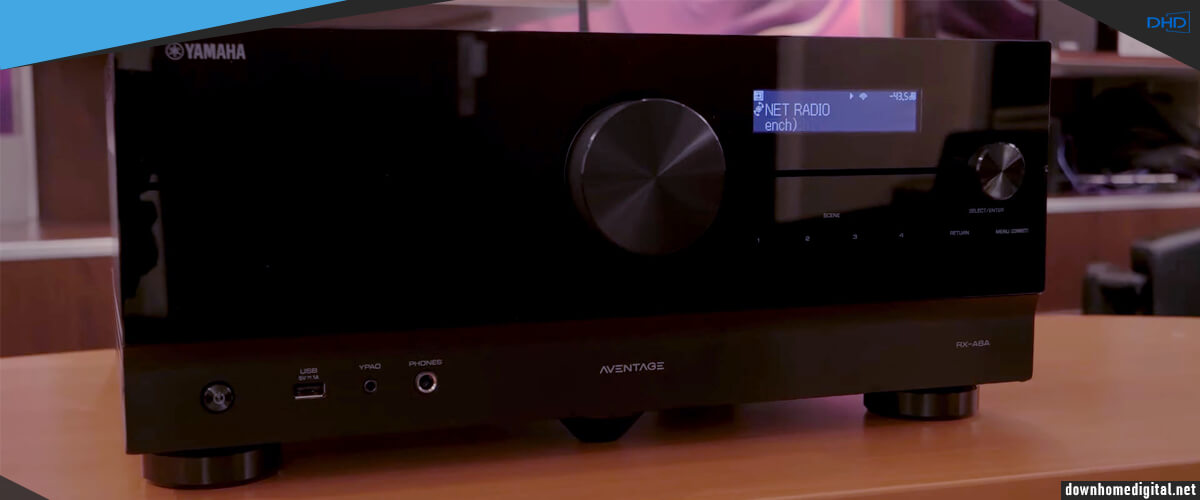
In the movie test, the Marantz SR6015 performed well. It combines precise signal processing. Clean, accurate, and powerful subwoofer calibration of the Audyssey SR6015 made the sound as adequate as possible to the size of the room and what was happening on the screen. In addition, even in the most significant noise, dialogues were always clearly understood and ideally positioned. Audyssey generally stands out among other systems because it adapts the sound as accurately as possible, and even an inexperienced user can handle it.
The situation is like the competing model. The Yamaha sounded excellent – very clear, dynamic, accurate, with deep and precise spaciousness. The sound field was well separated from all the speakers and floated naturally in the room. The effects were localized overhead, and the ambient noise spread widely and, most importantly, plausibly throughout the room. However, the YPAO calibration system lags far behind Audyssey and requires additional manipulation in manual settings.
When watching the movie “Dune” (in anticipation of the release of the second part, I decided to review the first part), both SR6015 and RX-A6A were great. But it’s worth realizing that fans of these brands are divided into two camps where some appreciate the warm, realistic sound of the Marantz, and others enjoy the crystallinity and chiseledness of the Yamaha. The difference is palpable when you view the same scene. When Paul commands his mother to get him water, and the background noise fades away, leaving us only the slight tinkle of ceiling decoration in the room, the Yamaha gives the impression of being immersed in hypnosis. But the moment the “voice” bursts into the frame, the Marantz gave away my sensations of eeriness, getting under my skin. This is a subjective judgment, and you have to choose the uniqueness of the sound to fit your tastes. So, I recommend listening to the receivers before you buy. They are just too unique.
Both the Yamaha RX-A6A and Marantz SR6015 are excellent mid-range receivers with a wide range of features. Both models support Wi-Fi, AirPlay 2, Bluetooth, voice control, and various music streaming services. The SR6015’s built-in HEOS module finds a worthy competitor in Yamaha’s MusicCast. Both receivers have 9 channels of amplification and 11 processing channels, support 8K video, and offer a huge assortment of surround sound formats. As you can see, the capabilities of these models are extensive and comparable.
But some differences may affect your choice. The Marantz SR6015 has less power, which may affect you if you expand your system to 11 channels and only 1 HDMI input is dedicated to 8K video. The Yamaha RX-A6A has no upscaling to 8K, and the YPAO automatic audio calibration system is far inferior to the competitor’s Audyssey. Most importantly, they sound radically different, not in terms of sound quality but in manner. And Yamaha’s cool gear has fewer fans. There’s no clear winner here, and I think it’s a real fighting draw, as the slightly outdated Marantz is still a bit cheaper.
| Key specs | Marantz SR6015 | Yamaha RX-A6A |
| Channels | 9.2 | 9.2 |
| Power output | 110 W/8 Ohm, 150 W/6 Ohm | 150 W/8 Ohm |
| HDMI inputs/outputs | 7/3 (8K/60Hz and 4K/120Hz pass-through) | 7/3 (8K/60Hz and 4K/120Hz pass-through) |
| Bluetooth/Wi-Fi | yes/yes | yes/yes |
| Video functions | video conversion analog to HDMI, analog to HDMI scaling, HDMI to HDMI scaling | video conversion analog to HDMI, analog to HDMI scaling, HDMI to HDMI scaling |
| Supports | HDMI ARC, HDMI eARC, HDMI CEC, HDCP2.3, HDR10, HDR10+, Dolby Vision | HDMI ARC, HDMI eARC, HDMI CEC, HDCP2.3, HDR10, HDR10+, Dolby Vision |
| Streaming services | AirPlay2, Spotify, Pandora, Tidal | AirPlay2, Spotify, Pandora, Tidal |
| Surround sound | DTS-HD Master Audio, DTS:X, DTS Neural:X, Dolby TrueHD, Dolby Digital Plus, Dolby Atmos, Dolby Surround, Dolby Atmos Height Virtualization, IMAX Enhanced | DTS-HD Master Audio, DTS:X, Dolby TrueHD, Dolby Digital Plus, Dolby Atmos, Dolby Surround, Dolby Atmos Height Virtualization, Auro 3D, Cinema DSP |
Marantz SR6015 pros and cons
Pros
- More user-friendly design with a protective cover.
- IMAX Enhanced.
- The Audyssey calibration system perfectly adapts the sound to the room, even if the user is inexperienced.
Cons
- Overheats when operated for long periods.
Yamaha RX-A6A pros and cons
Pros
- More power (150 watts) compared to the Denon AVR-X4700H.
- Surround:AI automatically optimizes the surround sound effect in real-time.
- Dolby Atmos and DTS:X with CINEMA DSP HD3 technology.
- The YPAO calibration system is inferior to Denon’s Audyssey MultEQ XT32.
Cons
- The cold sound will not suit everyone.
Premium Marantz and Yamaha receivers comparison
Marantz CINEMA 50 vs Yamaha RX-A8A
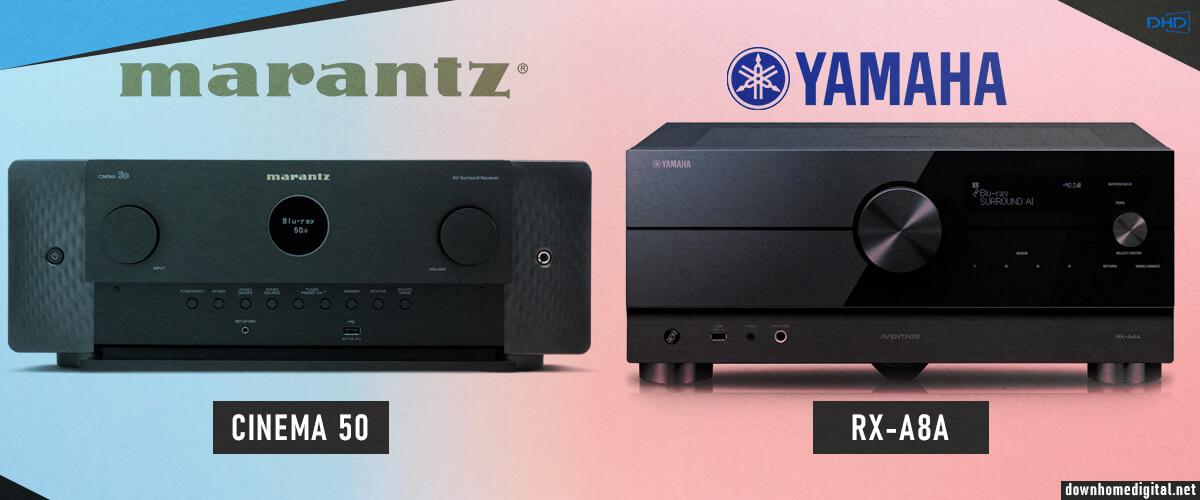
In the premium segment of my review are models with identical prices but different features, starting with the number of amplification channels. The Marantz CINEMA 50 has 9 channels, but with an additional amplifier, you can expand the system to 11 channels (as in the case of the SR6015). The difference is that the CINEMA 50 has pre-outputs for 4 independent subs. The Yamaha RX-A8A has 11 full channels, and only 2 subwoofers can be connected. Given the different power outputs of 110 watts (Marantz) and 150 watts (Yamaha), these configurations will, in reality, have the same quality result. Still, I didn’t get enough power for 11 channels from the CINEMA 50 (for 9 channels, it sounds like a beast). It’s also a question of whether you accept having more elements in the system, more variation with it, or whether you want fewer components.
Regarding construction and design, I can pretty much repeat word for word the description of the previous pair. But the CINEMA 50 looks more modern than the brand’s older lines. It’s gotten to the point where there are no inputs on the back panel for older equipment. Whether that’s a good or bad thing is up to you. It’s just that the company has started releasing new generation models (release year 2022). RX-A8A (2021), in its turn, does not differ from A6A. The same glossy surface requires care and handling with gloves. But it is beautiful – that’s for sure. Both models use high-quality components; the control is smooth, soft, sensitive, and precise. Gold-plated RCA connectors are also a sign of elite. Weight is again a difference maker. The Yamaha’s massive 47.2 pounds and optional anti-resonance design are significantly heavier than the Marantz’s 29.8 pounds. And more weight always indicates better quality and resistance to vibration. That’s important. Meanwhile, the CINEMA 50’s setup and control application is childishly delightful in its simplicity but not primitive.
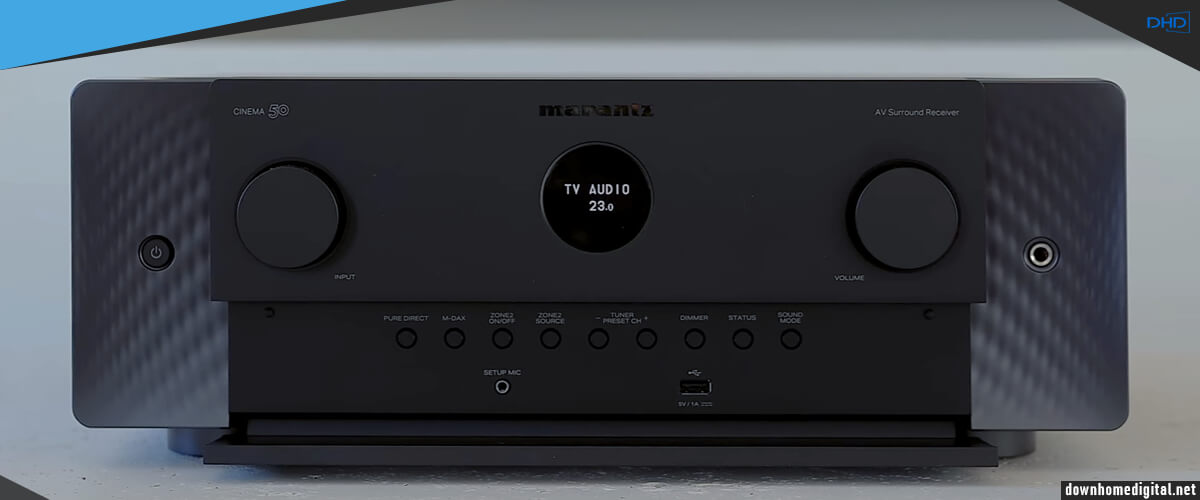
The video path is HDMI version 2.1, and both receivers support 8K video and a wide range of HDR formats, with HDCP 2.3 protection and eARC. The CINEMA 50 has only 6 inputs, while the RX-A8A has 7. But I had plenty of room for connectivity in both cases. Yamaha has taken the trouble to equip their receiver with upscaling to 8K this time, but I liked improving video resolution with the Marantz. I noticed no significant flaws, while the A8A had more frequent pixel popping and short video lag.
As far as stereo is concerned, the receivers are on about the same level. I won’t even list the number of wireless capabilities and supported streaming services so as not to waste your time. The quality will satisfy anyone, as both brands have built their unique multi-room systems, HEOS and MusicCast, and have perfected them. The only difference in the Bluetooth capabilities I noted was Yamaha’s support for the AAC codec. But in practice, I didn’t notice any difference for Apple equipment using it with the Marantz. For the CINEMA 50, it’s worth noting the use of Current Feedback Topology and HDAM, which the brand uses in its high-end models. They help create incredible sound quality, and that’s the kind of thing you pay a high price for. But the RX-A8A’s internal components are just as good, and the stereo sounds great.
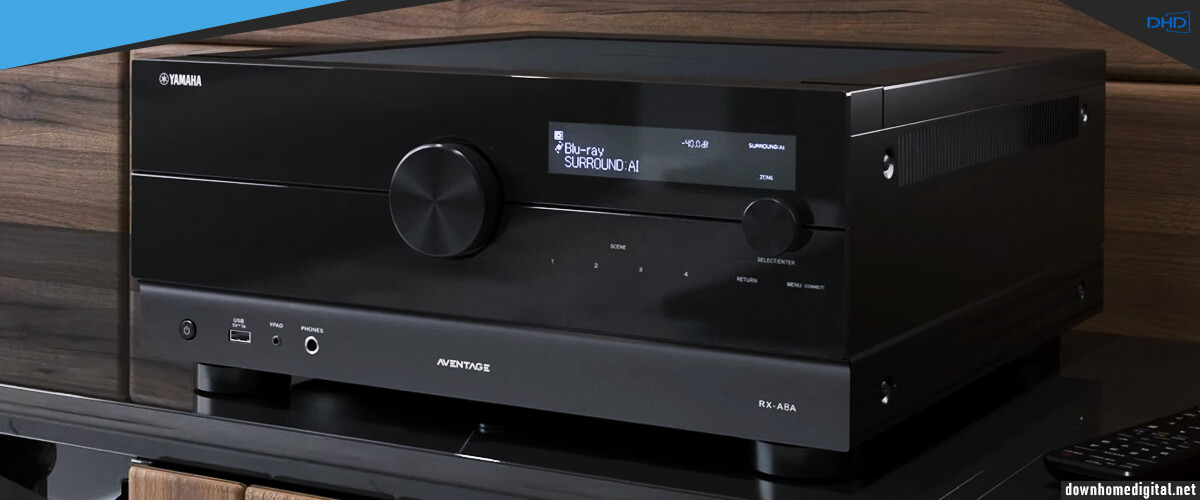
The picture is about the same in movies as in the previous mid-segment pair. There is a significant difference in the intonation of sound transmission (warm in Marantz and crystal cold in Yamaha), which is a matter of your taste only. Surround sound formats are supported across the spectrum, and we have all the same differences in IMAX availability for DTS:X in the Marantz and CINEMA DSP HD3 in the Yamaha. I like what these two buddies do, and I don’t think you’ll go wrong in your choice unless you have a clear preference for sound temperature. However, if you have a large home with multiple zones, the RX-A8A offers multi-room video for 3 zones and surround sound for 4, while the Marantz only provides 3. It’s the same situation with calibration, and long ago, Yamaha needed to change their approach to YPAO and refine it to modern standards. But you have Artificial Intelligence (AI) technology built into the DSP that analyzes and optimizes surround sound in real-time.
But let’s get to the point. Yamaha has succeeded in creating a natural home theater experience. The rich sound and wide soundstage put me right in the center of the movie. The RX-A8A was impressed with its lively sound, which did not become harsh even at high volume levels. At the same time, the Marantz delivered a wide dynamic range and a rich, sprawling sound that was better than the competition’s test. And for all that power, the receiver’s sound is fast and agile, with precise transient response and full control of the acoustics.
So, in conclusion, we can say that these two receivers are more suited to each other than competitors. The CINEMA 50 is designed for home theater, but its stereo performance is natural and lively. The RX-A8A is more crisp and concrete. However, both receivers show excellent phase play, dispersion, and frequency separation when you use measuring instruments. So it’s worth choosing based on your needs. Yamaha offers more original gain channels, power, and service areas. Marantz scores points by adding an amplifier, 4 subs, and unique sound processing technologies. Choose with your heart, and listen to these AVRs side by side. It will help. That said, the quality of both models is simply top-notch. They will last for you and your children and grandchildren unless there are some radical new trends in the world of surround sound. So what’s so surprising is that these are the latest additions to the high-end lineup of both brands.
| Key specs | Marantz CINEMA 50 | Yamaha RX-A8A |
| Channels | 9.4 | 11.2 |
| Power output | 110 W/8 Ohm, 150 W/6 Ohm | 150 W/8 Ohm |
| HDMI inputs/outputs | 6/3 (8K/60Hz and 4K/120Hz pass-through) | 7/3 (8K/60Hz pass-through) |
| Bluetooth/Wi-Fi | yes/yes | yes/yes |
| Video functions | Video conversion analog to HDMI, analog to HDMI scaling, HDMI to HDMI scaling | Video conversion analog to HDMI, analog to HDMI scaling, HDMI to HDMI scaling |
| Supports | HDMI ARC, HDMI eARC, HDMI CEC, HDCP2.3, HDR10, HDR10+, Dolby Vision | HDMI ARC, HDMI eARC, HDMI CEC, HDCP2.3, HDR10, HDR10+, Dolby Vision |
| Streaming services | AirPlay2, Spotify, Pandora, Tidal | AirPlay2, Spotify, Pandora, Tidal |
| Surround sound | DTS-HD Master Audio, DTS:X, DTS Neural:X, Dolby TrueHD, Dolby Atmos, Dolby Surround, Dolby Atmos Height Virtualization, IMAX Enhanced, Auro 3D | DTS-HD Master Audio, DTS:X, Dolby TrueHD, Dolby Digital Plus, Dolby Atmos, Dolby Surround, Cinema DSP, Auro 3D |
Marantz CINEMA 50 pros and cons
Pros
- The CINEMA 50 system can be expanded to 11 channels.
- You can connect 4 subwoofers.
- The app offers extensive customization and system control options.
- The 1080P/4K upscaling function to 8K works perfectly.
- Marantz’s current feedback topology and HDAM help create incredible sound quality.
Cons
- No inputs for older equipment.
- Not powerful enough for an 11-channel system.
Yamaha RX-A8A pros and cons
Pros
- Massive 47.2-pound weight and optional anti-resonance design.
- Multi-room video for 3 zones and surround sound for 4 zones.
- Unique CINEMA DSP HD3 technology for concert sound.
- Artificial Intelligence (AI) technology embedded in the DSP analyzes and optimizes surround sound in real-time.
Cons
- The system cannot be expanded, and only 2 subs can be connected.
- Not good 8K upscaling.
Marantz SR7015 vs Yamaha RX-A3080
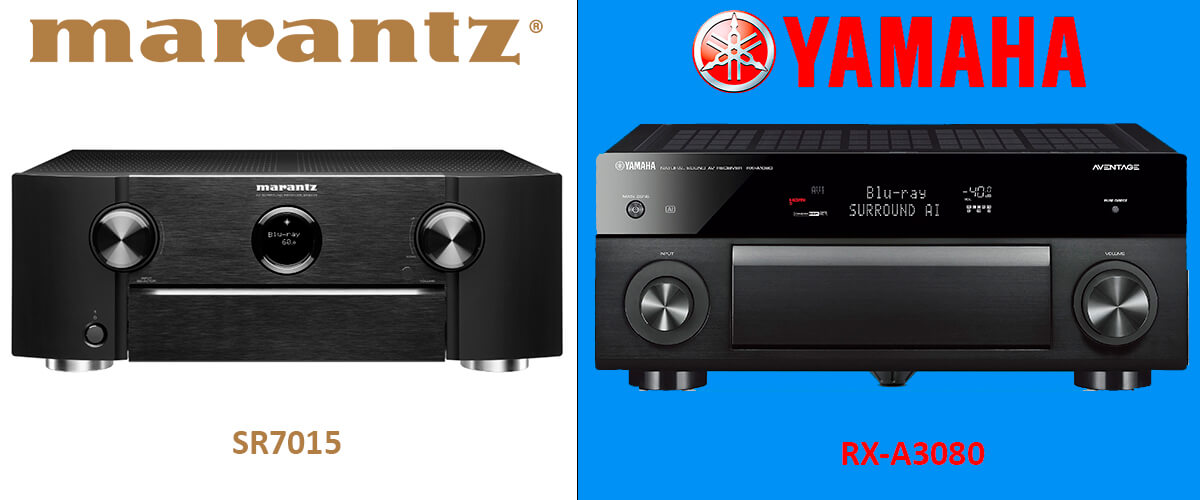
And the first of the pair is a 9-channel AV amplifier with 125 W/ Ohm and 165W /6 Ohm. The SR7015 supports Dolby Atmos, DTS: X, and Auro-3D (up to 11.2ch) and is IMAX Enhanced certified. The Yamaha RX-A3080 differs from the competitor in its more balanced approach to the design of both digital and analog parts. Moreover, the device has sufficient power. The amplifiers deliver 150 watts (into 8 ohms) for each channel at full load.
The SR7015 can handle 8K video, but only on one input and two outputs. All other inputs process signals in accordance with the HDMI 2.0 standard but also master modern video functions. Besides Dolby Vision and HLG, Marantz also understands HDR10 + and the new Dynamic HDR.
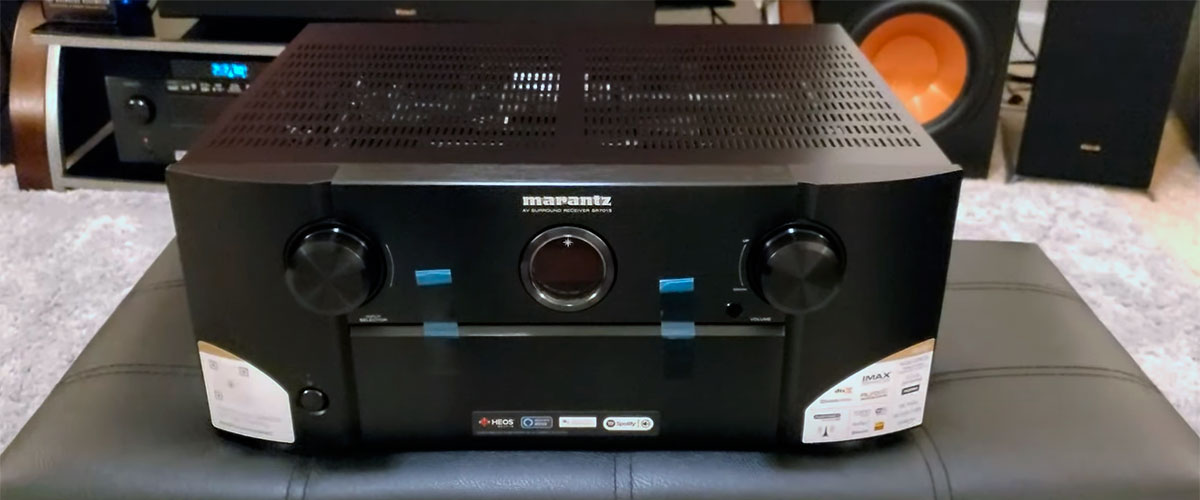
And the receiver from Yamaha loses to its competitor in video processing. Its video subsystem can work only with UltraHD video streams. However, I have to say that in addition to the ability to pass 4K video through itself, there is support for HDR10 and the Dolby Vision standard.
I tested the receivers as usual with the film. Again, the Yamaha`s receiver has managed to create a natural home theater feel. The rich sound and wide soundstage put me in the very center of the film. In stereo, the RX-A3080 impressed with its lively sound that never got harsh, even at high volume levels.
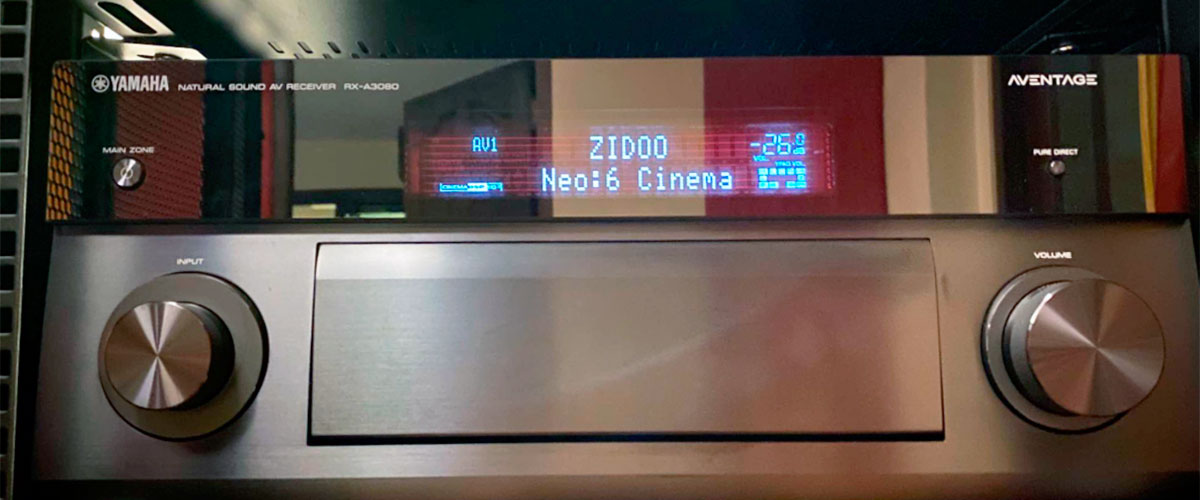
The Marantz SR7015, on the other hand, delivers impressive sound whether it operates in dual or multi-channel modes or plays 3D audio. What impressed me immediately about it was its substantial headroom, which ensures confident-sounding even when all channels are actively used. The result is a wide dynamic range and rich, sweeping sound which is better as in the competitor’s test. And for all that power, the receiver’s sound is fast and agile, with the accurate transient response and complete acoustics control.
And according to the results of testing, I can say that both receivers reviewed above sound very close. However, the SR7015 seems to be more versatile because of its unchanged dynamism. Alternatively, the RX-3080 is an excellent choice for vinyl due to its soft and warm sound.
| Key specs | Marantz SR7015 | Yamaha RX-A3080 |
| Channels | 9.2 | 9.2 |
| Power output | 125 W/8 Ohm, 165 W/6 Ohm | 150 W/8 Ohm |
| HDMI inputs/outputs | 8/3 (8K/60Hz and 4K/120Hz pass-through) | 7/3 (4K/60Hz pass-through) |
| Bluetooth/Wi-Fi | yes/yes | yes/yes |
| Video functions | video conversion analog to HDMI, analog to HDMI scaling, HDMI to HDMI scaling | analog to HDMI scaling, HDMI to HDMI scaling |
| Supports | HDMI ARC, HDMI eARC, HDMI CEC, HDCP2.3, HDR10, HDR10+, Dolby Vision | HDMI ARC, HDMI eARC, HDMI CEC, HDCP2.3, HDR10, Dolby Vision |
| Streaming services | AirPlay2, Spotify, Pandora, Tidal | AirPlay2, Spotify, Pandora, Tidal |
| Surround sound | DTS-HD Master Audio, DTS:X, DTS Neural:X, Dolby TrueHD, Dolby Atmos, Dolby Surround, Dolby Atmos Height Virtualization, IMAX Enhanced, Auro 3D | DTS-HD Master Audio, DTS:X, Dolby TrueHD, Dolby Digital Plus, Dolby Atmos, Dolby Surround, Cinema DSP |
Marantz SR7015 pros and cons
Pros
- Dolby Atmos, DTS: X, Auro-3D, and IMAX Enhanced decoders.
- EARC support.
Cons
- Only one 8K/60Hz input.
Yamaha RX-A3080 pros and cons
Pros
- Innovative audio processing with select components, Dolby Atmos compatible.
- Intelligent network / multi-room functions, superior equipment quality.
Cons
- No decoder for Auro 3D.
Budget Marantz and Yamaha AV receivers comparison
Yamaha RX-V6A vs Marantz NR1510
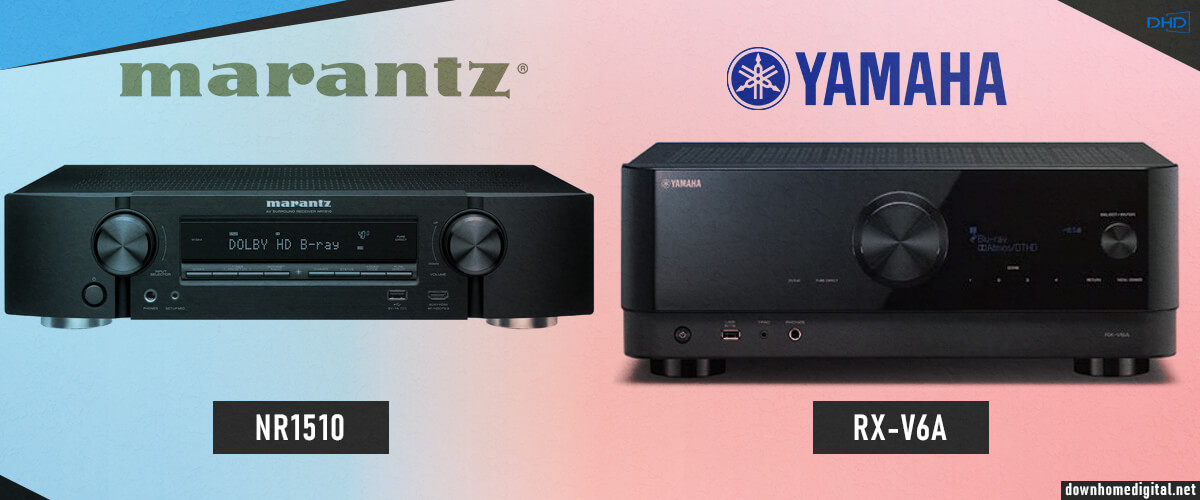
And now the budget segment is next in line. Here I have a Yamaha RX-V6A with 100 W / 8 Ohm per channel and a less powerful Marantz NR1510 with 50 W / 8 Ohm or 60 W / 6 Ohm. In the RX-V6A, I immediately want to note support for Dolby Atmos with the function of synthesis of virtual high channels, as well as Cinema DSP 3D. About the NR1510, I can only say that it does not have Dolby Atmos or DTS: X surround sound decoders. It is based only on Dolby TrueHD and DTS HD Master Audio. The number of amplification channels simply explains this. The RX-V6A has 7.2 channels, while the NR1510 has only 5.2. The power is also justified because the Marantz model has a narrow design, and in such receivers, this indicator is always reduced so that the device does not overheat.
The low-profile Marantz looks classic, has a full bright LCD, and a standard set of push-button controls on the front panel. The Yamaha RX-V6A is not in the Aventage lineup but follows a modern design with a glossy surface that makes me shudder. The plastic panel feels too flimsy to the touch, though, and the volume control doesn’t rotate as smoothly as the Marantz. Nevertheless, you may wonder why, with such differences, the cost of the receivers is almost the same. I can explain it with the example of buying an auto. For example, you have an old, reliable Mercedes in front of you. It has driven before and will drive after you, although it lags in some modernity. This is Marantz. Yamaha is more like a fast Honda. Great, modern, bright, shiny. The only problem is it’s not a Mercedes. And that’s the same for every pair in my review.
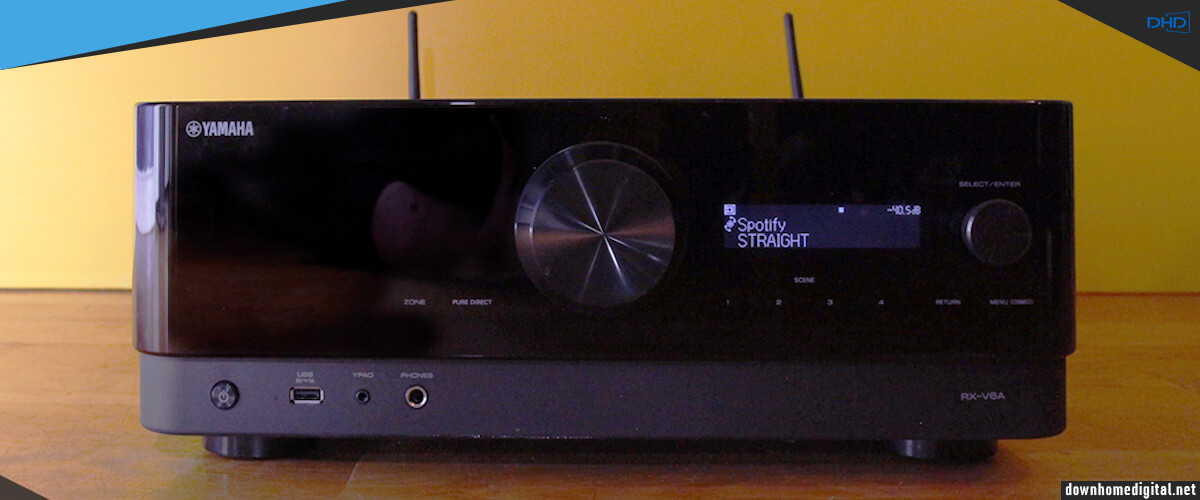
The Yamaha RX-V6A has a good HDR10 + video path for more realistic images and 4K / 120Hz and 8K. Furthermore, music Enhancer enhances compressed audio. In addition, the device supports MusicCast multi-room technology and voice control. The Marantz NR1510 can be praised for having the latest version of the eARC system on the video path. There is also 4K, Dolby Vision, or HLG, but without scaling.
Having started my testing, I was pleasantly surprised. Yamaha conveyed the sound of the film impressively. The 3D effects seemed tangible and accurate, but the pitch effects played a little ahead. In the music compilation test, the V6A played as clean and airy as it was dynamic. The music was even believably spatial in some moments. Bass was reproduced cleanly, albeit a little underrepresented with the calibration settings.
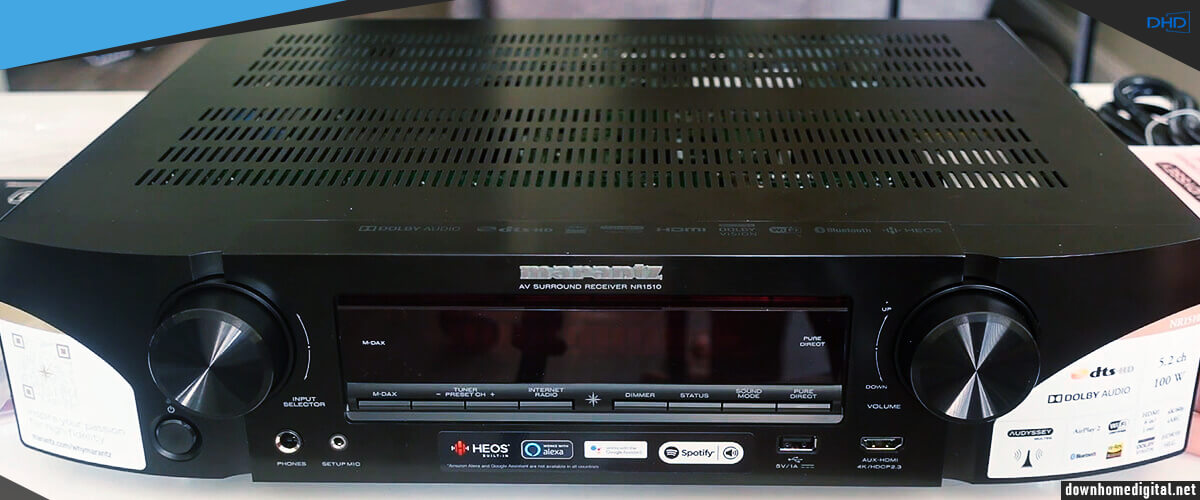
The Marantz NR1510 is excellent for stereo. The receiver broadcasts smooth and detailed sound. I could even call it soft, but here the damping is limiting the effect of the resolution. Even so, the sounds are rich and light, sonorous and gentle. It is less harsh than the competitor. The tonal balance is impeccable, although the sound is far from dry and dispassionate versions of neutrality. It also produces great surround sound in movies, but it’s hard to compare receivers when this one is inferior in channel count and just can’t support ceiling-mounted ones.
You are faced with representatives of the budget category with different capabilities at practically the same price. The Yamaha RX-V6A has 7 channels of amplification, which means support for Dolby Atmos and DTS: X. It has more power, more HDMI inputs (7), and also supports the latest 8K video resolution. The Marantz NR1510 only has 5 channels, supports basic old-generation surround sound formats, 4K video, and minimum power for AVR. So which one to choose?
I recommend taking a balanced approach to the decision. Where will you put ceiling speakers if you have a small room (about 150 square feet)? I want to ask you. And why? Surround sound in a standard 5.2 configuration is enough to give you an immersive experience. The 8K picture, in my opinion, is overrated, and there is not much content with this resolution today. Still, to stay on top of current trends, and in the case of a larger venue (up to 300 square feet), why not afford a little luxury in the form of overhead immersive channels? Think, choose, and remember that the main criteria are reliability and personal preference. Receivers aren’t so cheap that you don’t want to take the time to make an informed decision.
| Marantz NR1510 | Yamaha RX-V6A | |
| Channels | 5.2 | 7.2 |
| Power output | 100 W/8 Ohm | 50 W/8 Ohm, 60 W/6 Ohm |
| HDMI inputs/outputs | 6/1 (4K/60Hz pass-through) | 7/1 (8K/60Hz, 4K/120Hz pass-through) |
| Bluetooth/Wi-Fi | yes/yes | yes/yes |
| Video functions | 4K/60Hz pass-through in standby mode | 8K/60Hz, 4K/120Hz pass-throughh in standby mode, HDMI upscaling (up to 4K) |
| Multi-room zones | no | 2 |
| Supports | HDMI ARC, HDMI eARC, HDCP2.3, HDR10, Dolby Vision | HDMI ARC, HDMI eARC, HDCP2.3, HDR10, Dolby Vision |
| Streaming services | AirPlay2, Spotify, Pandora | AirPlay2, Spotify, Pandora |
| Surround sound | DTS-HD Master Audio, Audyssey | DTS-HD Master Audio, DTS:X, Dolby TrueHD, Dolby Digital Plus, Dolby Atmos, Dolby Atmos Height Virtualization, Dolby Surround, Cinema DSP |
Yamaha RX-V6A pros and cons
Pros
- Dolby Atmos, DTS: X, multiple sound programs.
- 8K support.
- 7 HDMI input ports.
Cons
- The flimsy plastic panel and volume control do not rotate smoothly.
Marantz NR1510 pros and cons
Pros
- Comfortable narrow profile.
- Rugged construction that will last longer than the Yamaha RX-V6A.
- Feels great in stereo and movies.
Cons
- Inferior to the competitor in channel count and does not support surround sound formats with upper channels.
- Does not support 8K video.
Stereo Marantz and Yamaha receivers comparison
Marantz NR1200 vs Yamaha R-N303
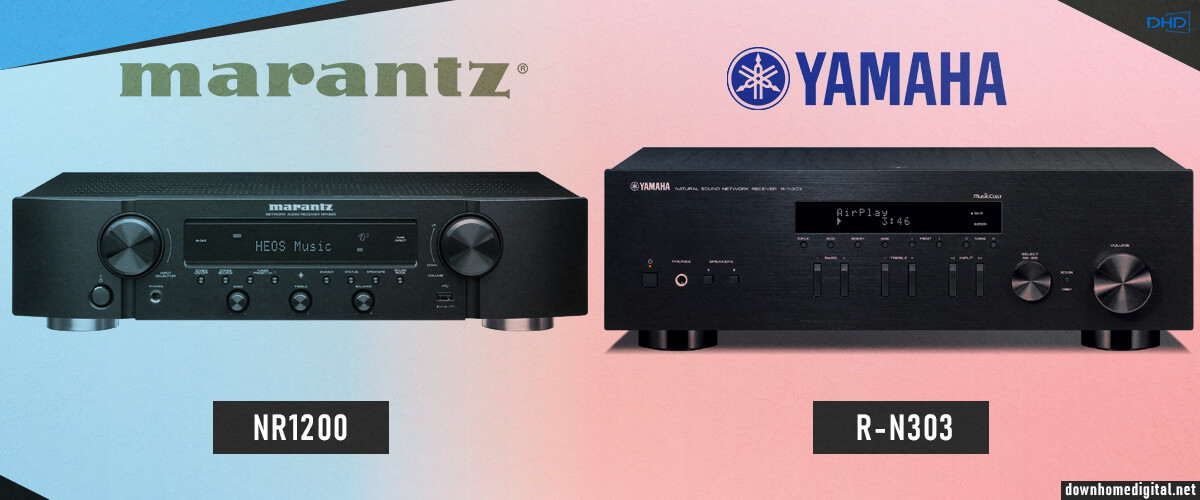
And at the end of the series of reviews, I propose to compare two models of stereo receivers. I’ll start with a model from Yamaha R-N303. This compact receiver is equipped with a suitable power transformer that delivers a maximum power of 100 W/8 Ohm or 120 W/6 Ohm. That kind of power seems impressive compared to the competition. The Marantz NR1200 has only 75 watts per channel. But it’s not that simple with this couple.
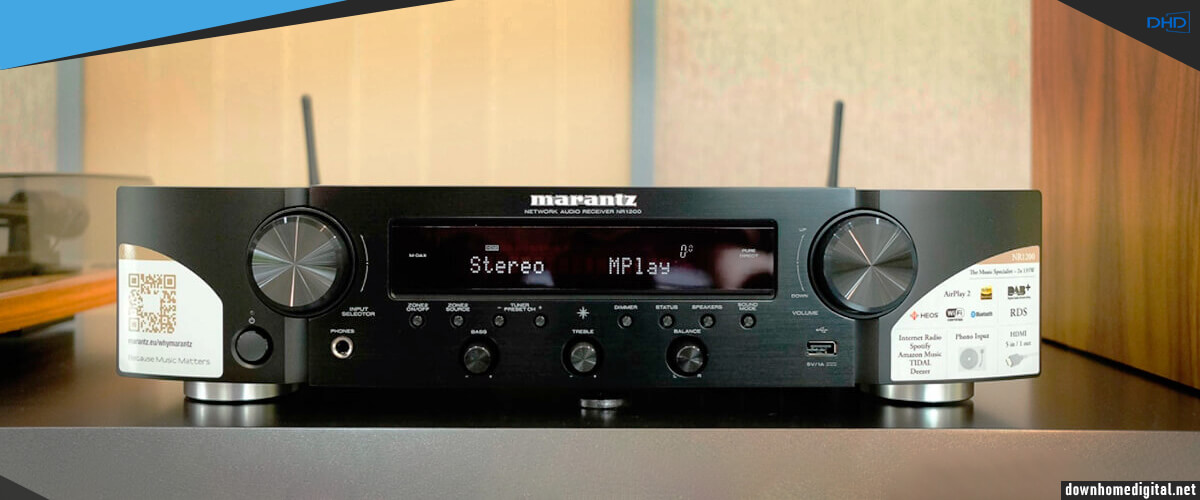
Regarding the construction, since the models were released quite a long time ago (2015 and 2019), both receivers have good cases. Today’s inexpensive stereo receivers are less reliable (as is often with new-generation tech). However, one major difference might influence your choice if you’re really savvy about sound and want to set up an optimal system for your hearing. A button adjusts the Yamaha R-N303’s treble and bass frequencies. You choose only the options offered by the manufacturer without intermediate nuances. The Marantz NR1200 has rotary controls for this, and I could find the desired ranges for myself quite accurately. Plus, it has more connectors.
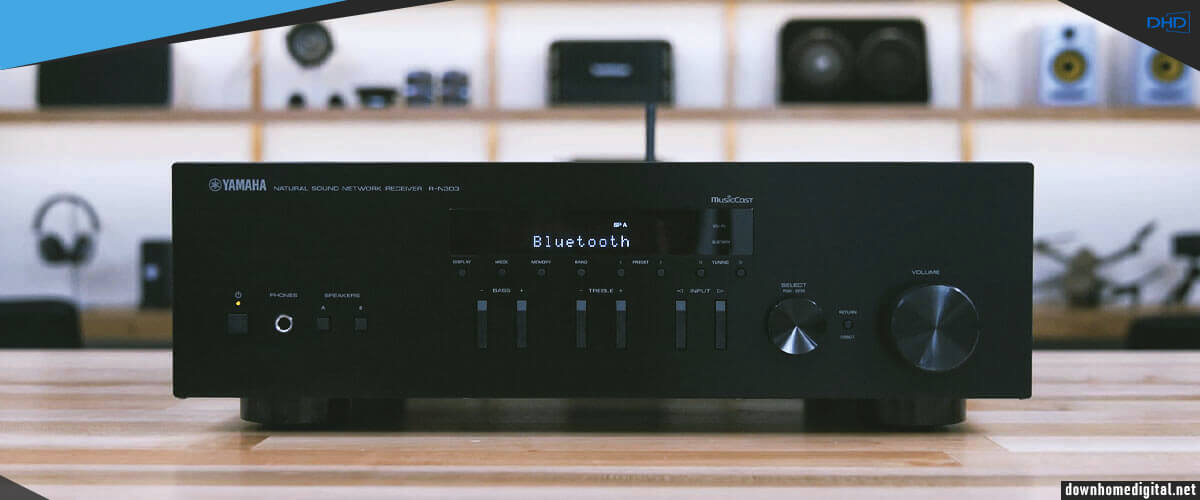
The NR1200 has its huge advantages. It connects five HDMI inputs, each supporting HDCP 2.3, 4K / 60Hz video, HLG, and more. In contrast, Yamaha has no video capabilities at all.
It is also worth noting that the Yamaha model has WLAN or LAN connections to the local network. Support is declared for TIDAL, Deezer, Qobuz, Napster, vTuner, Sirius XM, etc. And also, of the features – the model is equipped with a Bluetooth module, capable of receiving and broadcasting an audio stream to mobile devices, incl, on Bluetooth headphones. The networking capabilities of the Marantz NR1200 are pretty good too. In addition to standard Bluetooth and Wi-Fi, the presence of HEOS and support for Airplay 2 allow the model to be integrated into a multi-room installation.
As a result, I see it this way: the Marantz NR1200 has everything to become the center of a home multimedia system – excellent sound and picture and confident work with different speakers. That is, you get a kind of hybrid to connect a console, Blu-ray player, and other devices. At the same time, you get a full-fledged modern music center with wireless capabilities and multi-room audio HEOS. The R-N303 can function as a stereo center only. It’s also perfect for integrating your existing and favorite passive speakers into a multi-room system, thanks to the MusicCast feature. But even its setup is much simpler, as you choose the treble and bass frequencies from the manufacturer’s suggested (push-button setup). At the same time, the Marantz offers more distinct individual sound customization. It’s more modern, released in 2019, not 2015, like the Yamaha. With the cost spread more than doubling, the choice is easy, in my opinion, because both devices promise more than decent sound.
| Key specs | Marantz NR1200 | Yamaha R-N303 |
| Channels | 2.0 | 2.0 |
| Power output | 75 W/8 Ohm | 100 W/8 Ohm |
| HDMI inputs/outputs | 5/1 | 0/0 |
| Phono Input | yes | yes |
| Bluetooth/Wi-Fi | yes/yes | yes/yes |
| Streaming services | AirPlay2, Spotify, Pandora | AirPlay2, Spotify, Pandora |
Marantz NR1200 pros and cons
Pros
- 4K and eARC support.
- The ability to create HEOS multi room.
Cons
- Low power output.
Yamaha R-N303 pros and cons
Pros
- Powerful and dynamic sound.
- Multi-room MusicCast system.
Cons
- Lack of video section.
Discontinued models
I present a couple of fairly current, attractively priced (since discontinued) AVRs. These were released in 2018 and 2019, so they are inferior to more recent models in the video path and some other areas. However, for consumers who want excellent sound and build quality, they can be a worthy alternative to the modern features that the viewer will use.
Yamaha RX-A1080 vs Marantz SR5014
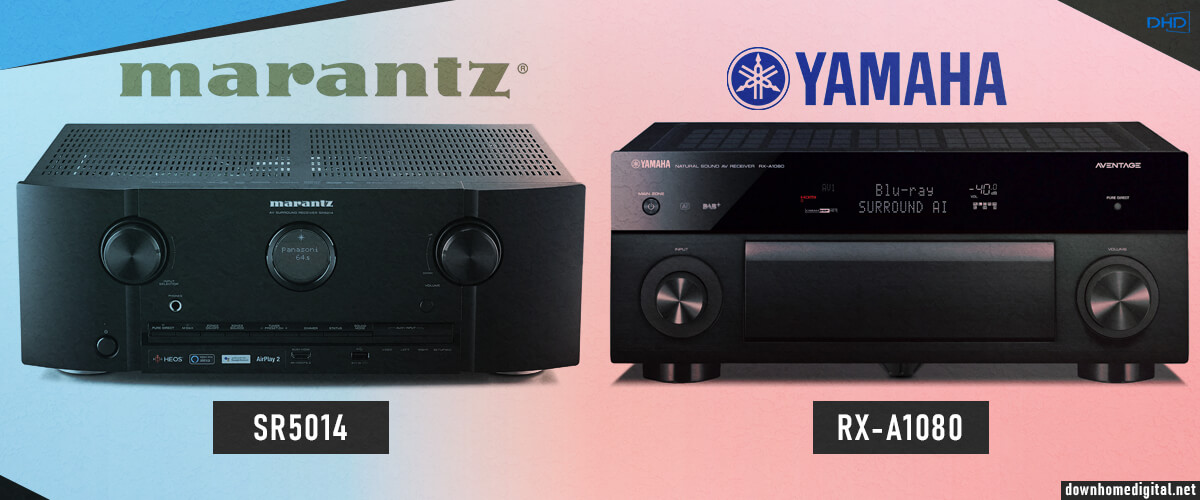
This section presents another pair of Marantz vs Yamaha mid-segment receivers. I started with audio specs, as always.
Yamaha is equipped with an amplifier with 110 W/8 Ohm, which allows you to drive 5.1, 7.1, Dolby Atmos configurations. It also has its Presence system onboard and numerous DSP modes (including the Cinema DSP HD3, which requires the installation of seven physical devices).
Alternatively, Marantz SR5014 is equipped with discrete, more powerful amplifiers capable of delivering 100 W/8 Ohm and 140 W/6 Ohm per channel, plus high currents on all nine channels. Plus, I want to highlight, the device is equipped with HDAM modules, which provide high quality without the slightest distortion and a wide dynamic range during high-resolution audio playback.
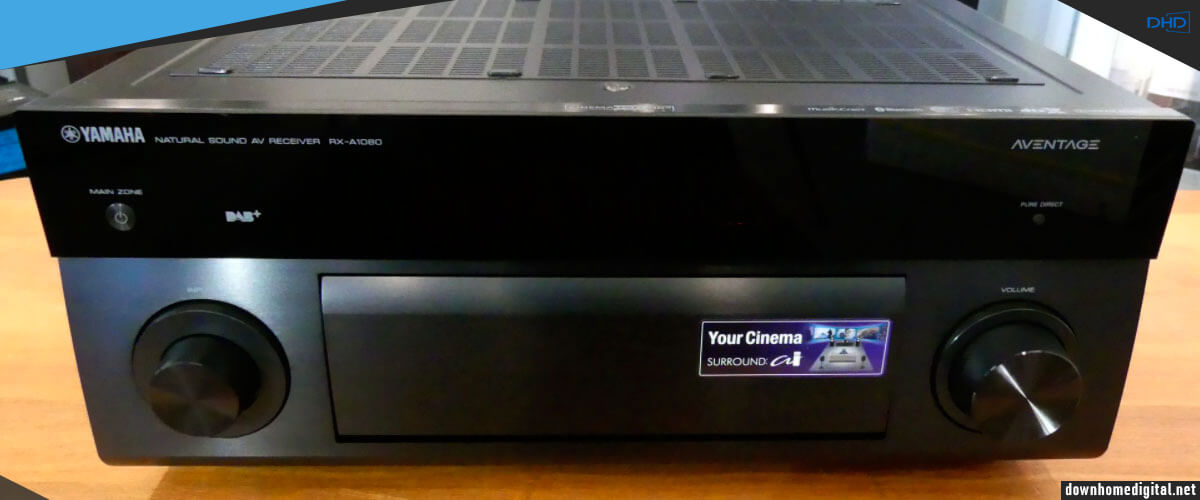
Yamaha perfectly processes a 4K video stream. In addition, all analog video signals input to the receiver are converted to digital and output to the monitor via HDMI. As a result, there are upscale images up to the 4K standard. And so is the competitor. The Marantz receiver supports Dolby Vision and the new HLG technology, which is currently the most advanced option for transmitting HDR images. In terms of video capabilities, the devices have parity.
It’s time to test. And I started, as always, by watching a movie. And as I expected, the SR5014 sounded pretty soft. The sound was tonal with a slight warm undertone. The bass was played quite soft and not very clear or explosive. I haven’t missed a single detail in uppercase. Marantz has an excellent high-frequency resolution.
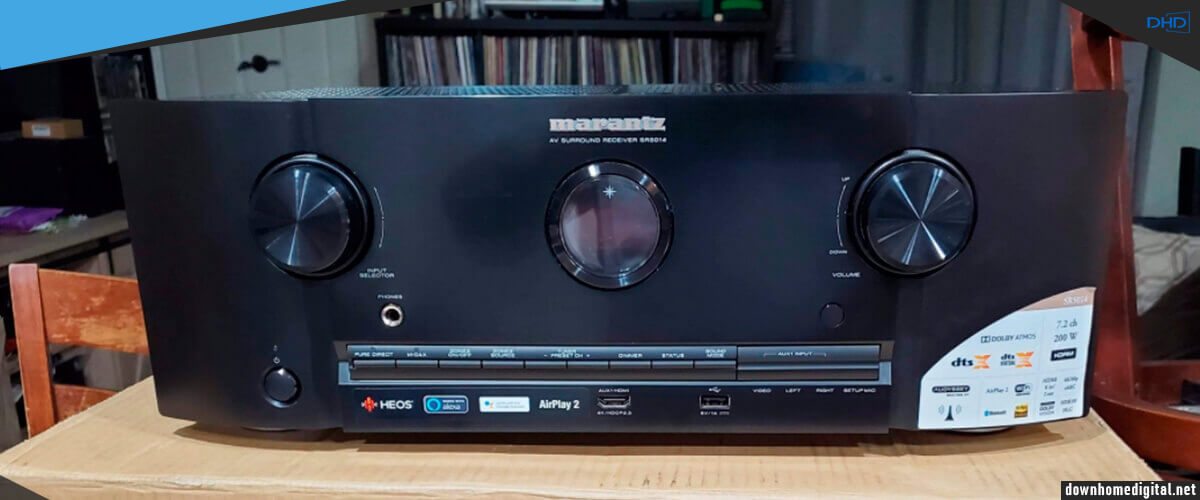
Yamaha’s sound is closer to the Marantz profile, and does not noticeably change the style when switching from stereo to multichannel. In music, this is expressed in naturalness, which should have freedom and dynamics. Paying attention, balance, and harmony prevail in the general perception – in this style, it is difficult to significantly improve anything to not spoil the whole composition. The music flows in a clean, unobstructed flow, has its tempo, turns, strokes, and flashes, but above all, it is connected.
And according to the results, the Marantz is distinguished by a good sound, advanced music features, and a wide variety of connections. However, the tested Yamaha RX-A1080 impresses with its detail and sensational musicality, especially when playing music in multichannel formats. And each of these models will be a valuable purchase for those who choose between Marantz or Yamaha.
| Key specs | Marantz SR5014 | Yamaha RX-A1080 |
| Channels | 9.2 | 9.2 |
| Power output | 100 W/8 Ohm, 140 W/6 Ohm | 110 W/8 Ohm |
| HDMI inputs/outputs | 8/2 (4K/60Hz pass-through) | 7/3 (4K/60Hz pass-through) |
| Bluetooth/Wi-Fi | yes/yes | yes/yes |
| Video functions | video conversion analog to HDMI, analog to HDMI scaling, HDMI to HDMI scaling | analog to HDMI scaling, HDMI to HDMI scaling |
| Supports | HDMI ARC, HDMI eARC, HDMI CEC, HDCP2.3, HDR10, HDR10+, Dolby Vision | HDMI ARC, HDMI eARC, HDMI CEC, HDCP2.3, HDR10, Dolby Vision |
| Streaming services | AirPlay2, Spotify, Pandora, Tidal | AirPlay2, Spotify, Pandora, Tidal |
| Surround sound | DTS-HD Master Audio, DTS:X, DTS Neural:X, Dolby TrueHD, Dolby Atmos, Dolby Surround, Dolby Atmos Height Virtualization | DTS-HD Master Audio, DTS:X, Dolby TrueHD, Dolby Digital Plus, Dolby Atmos, Dolby Surround, Cinema DSP |
Yamaha RX-A1080 pros and cons
Pros
- Excellent sound, especially in multichannel mode.
- Many DSP programs, including “Surround: Al”.
Cons
- No decoder for Auro-3D audio.
Marantz SR5014 pros and cons
Pros
- Outstanding performance.
- Excellent build quality.
Cons
- No HDR 10+ support.

